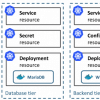Related Content
 |
Using a Multibranch Jenkins Pipeline with Docker Typically, code for a Docker image is developed using multiple GitHub branches, with each branch being the code for a single Docker image tag. However, having to create and run a Jenkins pipeline for each GitHub branch can be cumbersome. Try a multibranch pipeline to integrate multiple GitHub branches simultaneously. |
|
 |
Building Security into DevOps: A Slack Takeover with Larry Maccherone Thought leaders from the software community are taking over the TechWell Hub to answer questions and engage in conversations. Larry Maccherone, senior director at Comcast, hosted this Slack takeover and discussed what DevSecOps means, how to get started with security, and the changing role of security specialists. |
|
 |
Using Kubernetes Helm Charts for Increased DevOps Collaboration A Docker image is usually designed for a baseline functionality and can then be customized. However, customized resource definitions are typically not shared among other users who might have a similar application requirement. Here’s where Helm charts for Kubernetes can help reduce rework and increase collaboration. |
|
 |
How to Get Security Groups to Join Your DevSecOps Journey DevSecOps shifts security practices left and assures earlier that your application isn't vulnerable to breaches. But convincing a security group to get on board with your DevSecOps journey may not be an easy task. These four points can help you prove to your security group that DevSecOps is in everyone’s best interest. |
|
|
|
Why Use Kubernetes for Your Container Management? Kubernetes is the most commonly used open source orchestration framework for containers. It’s used for automating deployment, scaling, and management of application containers and works with many container tools, including Docker. But what makes Kubernetes so popular? And would it be useful to you? Let's take a look. |
|
 |
5 Ways to Shift Performance Testing Left Performance testing is often a barrier to accelerating software delivery. Because you need a production-like environment, performance testing often waits until the entire application is complete. But you shouldn't wait until then to get started. You can begin testing earlier to reduce rework and address issues sooner. |
|
 |
Scrum Can Help You See the Forest and the Trees In project management, it's easy to focus on details to the extent that you lose track of the larger goal. Scrum can help you identify flaws and gaps, and skipping or trivializing Scrum events will just hide the fact that there are things you need to improve. Finding problems is something to be celebrated, not hidden. |
|
 |
Get Your Defect-Tracking Database Back on Track When defects are ignored or mismanaged, it can compromise the integrity of the defect-tracking database. When this happens, defects could go unfixed, or code fixes may not be verified by the production release. Before you can resolve a compromised defect-tracking database, you need to know how to recognize one. |






